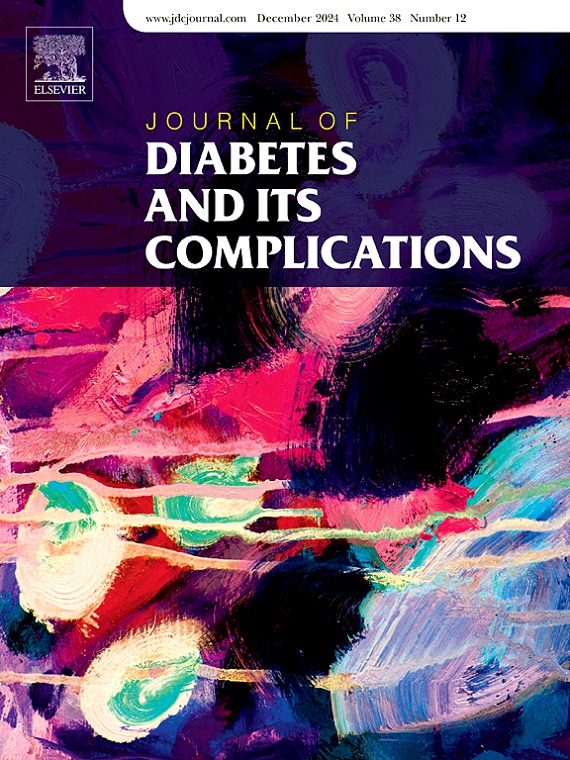FIB-4 predicts events in compensated advanced chronic liver disease and type 2 diabetes treated with GLP-1-receptor-agonists
IF 2.9
3区 医学
Q3 ENDOCRINOLOGY & METABOLISM
引用次数: 0
Abstract
Background & aims
Patients with compensated advanced chronic liver disease (cACLD) and treated type 2 diabetes have an increased risk for liver-related events, but data regarding this population is lacking, particularly, taking into account novel treatments. We assessed the role of Fibrosis-4 index and other variables to predict events.
Methods
First hepatic decompensation, liver transplantation (OLT), death, hepatocellular carcinoma (HCC) and bacterial infections over a follow-up period of 28.7 (16–49.4) months were retrospectively identified from 106 patients with treated type 2 diabetes and liver stiffness measurement >10 kPa suggesting ACLD. We identified predictors of events using Cox regression. Additionally, we evaluated treatment effect with add-on GLP-1 receptor agonists (GLP-1-RA) compared to other antidiabetic medications.
Results
FIB-4 was associated with hepatic decompensation, OLT and death (HR 1.517, 95%CI 1.226–1.879, p ≤ 0.001), HCC (HR 1.369, 95%CI 1.046–1.791, p = 0.022) and bacterial infections (HR 1.379, 95%CI 1.118–1.702, p = 0.003). Propensity score adjusted analysis for GLP-1-RA treatment did not show an effect (HR 0.240, 95%CI 0.044–1.315, p = 0.1). Survival was worse in those with more advanced disease defined by FIB-4 > 2.67 (p = 0.02).
Conclusion
FIB-4 is a strong prognostic tool to screen patients and refer them to specialists, in cACLD patients and pharmacologically treated type 2 diabetes, irrespective of treatment.
FIB-4预测glp -1受体激动剂治疗代偿晚期慢性肝病和2型糖尿病的事件
背景,目的代偿性晚期慢性肝病(cACLD)患者和接受治疗的2型糖尿病患者发生肝脏相关事件的风险增加,但缺乏关于这一人群的数据,特别是考虑到新的治疗方法。我们评估了纤维化-4指数和其他变量在预测事件中的作用。方法回顾性分析106例2型糖尿病患者的首次肝失代偿、肝移植(OLT)、死亡、肝细胞癌(HCC)和细菌感染,随访28.7(16-49.4)个月,肝硬度测量值10kpa提示ACLD。我们使用Cox回归确定事件的预测因子。此外,我们评估了附加GLP-1受体激动剂(GLP-1- ra)与其他降糖药物的治疗效果。结果fib -4与肝功能失代偿、OLT、死亡(HR 1.517, 95%CI 1.226 ~ 1.879, p≤0.001)、HCC (HR 1.369, 95%CI 1.046 ~ 1.791, p = 0.022)、细菌感染(HR 1.379, 95%CI 1.118 ~ 1.702, p = 0.003)相关。倾向评分校正分析显示GLP-1-RA治疗没有效果(HR 0.240, 95%CI 0.044-1.315, p = 0.1)。FIB-4定义的晚期疾病患者的生存率更差;2.67 (p = 0.02)。结论fib -4是一种强有力的预后工具,可用于筛查cACLD患者和经药物治疗的2型糖尿病患者,并将其转诊给专科医生。
本文章由计算机程序翻译,如有差异,请以英文原文为准。
求助全文
约1分钟内获得全文
求助全文
来源期刊

Journal of diabetes and its complications
医学-内分泌学与代谢
CiteScore
5.90
自引率
3.30%
发文量
153
审稿时长
16 days
期刊介绍:
Journal of Diabetes and Its Complications (JDC) is a journal for health care practitioners and researchers, that publishes original research about the pathogenesis, diagnosis and management of diabetes mellitus and its complications. JDC also publishes articles on physiological and molecular aspects of glucose homeostasis.
The primary purpose of JDC is to act as a source of information usable by diabetes practitioners and researchers to increase their knowledge about mechanisms of diabetes and complications development, and promote better management of people with diabetes who are at risk for those complications.
Manuscripts submitted to JDC can report any aspect of basic, translational or clinical research as well as epidemiology. Topics can range broadly from early prediabetes to late-stage complicated diabetes. Topics relevant to basic/translational reports include pancreatic islet dysfunction and insulin resistance, altered adipose tissue function in diabetes, altered neuronal control of glucose homeostasis and mechanisms of drug action. Topics relevant to diabetic complications include diabetic retinopathy, neuropathy and nephropathy; peripheral vascular disease and coronary heart disease; gastrointestinal disorders, renal failure and impotence; and hypertension and hyperlipidemia.
 求助内容:
求助内容: 应助结果提醒方式:
应助结果提醒方式:


